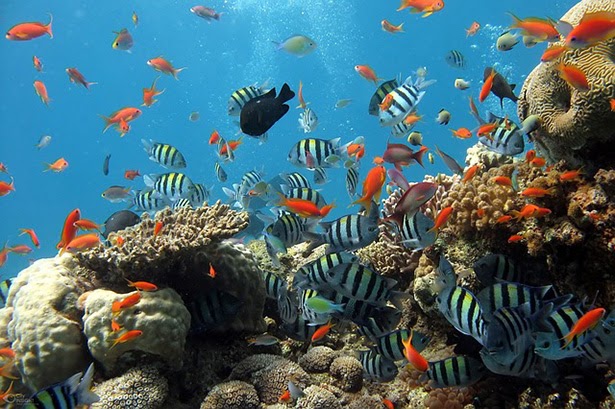Water is an essential medium for all living processes of biota. Approximately, 71 % of the earth’s surface is covered by ocean. The aquatic ecosystem constitutes the marine environments of the seas called ‘marine ecosystem’ and the fresh water systems in lakes, rivers, streams, ponds and wetlands called ‘fresh water ecosystem’. These ecosystems provide human beings with a wealth of natural resources. Freshwater ecosystems are further of standing type (lentic) like ponds and lakes or free-flowing type (lotic), like rivers and streams. Freshwater ecosystems are influenced by local climate, soil, resident communicates and also on surrounding terrestrial ecosystems.
(a) Pond ecosystem: It is a small freshwater aquatic ecosystem where water is stagnant. Ponds may be seasonal in nature i.e. receiving enough water during rainy season. Ponds are usually shallow water bodies which playa very important role in the villages where most of the activities center around ponds. They contain several types of algae, aquatic plants, insects, fishes and birds. The ponds are, however, very often exposed to tremendous anthropogenic (human-generated) pressures. They are used for washing clothes, bathing, swimming, cattle bathing and drinking etc. and therefore get polluted.
(b) Lake ecosystems: Lakes are usually big freshwater bodies with standing water. They have a shallow water zone called Littoral zone, an open-water zone where effective penetration of solar light takes place, called Limnetic zone and a deep bottom area where light penetration is negligible, known as profundal zone.
Some famous lakes in India are the Dal Lake in Srinagar (J & K) and Naini Lake in Nainital (Uttarakand).
Several types of organisms live in lake environment:
(a) Planktons: phytoplanktons like algae and zooplanktons like rotifers float on the surface of the lakes.
(b) Nektons are the fish species that live in water.
(c) Neustons that rest or swim on the surface.
(d) Benthos are living in the bottom of the lakes in sediments e.g. snails.
(e)Periphytons that are attached or clinging to other plants or any other surface e.g. crustaceans.
Stratification : The lakes contain different strata or zones based on temperature differences. During summer, the water in the top layers get warmer than the water in the bottom layers. The warm water in the top layer circulates without mixing with the colder layer at the bottom, thus forming a distinct zonation.
The lighter warm circulating surface layer is called as Epilimnion and the cold non-circulating bottom layer of viscous nature is called Hypolimnion.
The layer in between the two layers is known as thermocline.
Types of Lakes: Some important types of lakes are:
(a) Oligotrophic lakes are having low nutrient concentrations.
(b) Eutrophic lakes are with agricultural runoff or municipal sewage discharge in the water body. They are over nourished by nutrients like nitrogen and phosphorus. They are covered with “algal blooms” and many lakes in India are having this problem as most of the lakes are serving as drainage water bodies.
(c) Dystrophic lakes that have low pH, high humic acid content and brown waters.
(d) Endemic lakes are invariably ancient and very deep. They have endemic fauna.
The Lake Baika ,in Russia is a deep lake, which is now suffering due to industrial pollution.
(e) Desert salt lakes occur in arid regions. They are with high salt concentrations as a result of high evaporation. e.g. Sambhar lake in Rajasthan.
(f) Volcanic lakes receive water from magma after volcanic eruptions
(g) Meromictic lakes are rich in salts and are permanent stratified.
(h) Artificial lakes or impoundments are created by the construction of dams.
Streams
These are freshwater aquatic ecosystems where water current is a major controlling factor, oxygen and nutrient in the water is more uniform and land-water exchange is more extensive. Although stream organism have to face more extremes of temperature and action of currents as compared to pond or lake organisms, but they do not have to face oxygen deficiency under natural conditions. This is because the stream are shallow, have a large surface exposed to air and constant motion which churns the water and provides abundant oxygen. Their dissolve
oxygen level is higher than that of ponds even though the green plants are much less in number. The stream animals usually have a narrow range of tolerance to oxygen. That is the reason why they are very susceptible to any organic pollution which depletes dissolved oxygen in the water. Thus, streams are the worst victims of industrial
development.
River Ecosystem: Rivers are large streams that flow downward from mountain highlands and flowing through the plains fall into the sea. So the river ecosystems show a series of different conditions.
The mountain highland part has cold, clear waters rushing down as water falls with large amounts of dissolved oxygen. The plants are attached to rocks (periphytons) and fishes are cold-water, high oxygen requiring fish like trouts.
In the second phase on the gentle slopes, the waters are warmer and support a luxuriant growth of plants and less oxygen requiring fishes.
In the third phase, the river waters are very rich in biotic diversity. Moving down the hills, rivers shape the land. They bring with them lots of silt rich in nutrients which is deposited in the plains and in the delta before reaching the ocean.
Wetlands:
Wetlands are ecosystems in which the land surface is saturated or covered with standing water at least part of the year. The wetland vegetation is adapted for growth under saturated water conditions. Wetlands can be classified into Swamps, Marshes and Bogs and fens. In swamps trees are there whereas marshes are without trees. Bog and fens are waterlogged areas saturated by groundwater or rainwater. As the water depth in swamps and marshes is shallow, enough sunlight will penetrate inducing higher photosynthetic activity. Because of this, more biomass production and greater species diversity can be observed. Vast stretch of wetlands are available in Canada and Russia. Migratory birds use wetlands for breeding.
Oceans
These are gigantic reservoirs of water covering more than 70% of our earth’s surface and play a key role in the survival of about 2,50,000 marine species, serving as food for humans and other organisms, give a huge variety of sea-products and drugs. Oceans provide us iron, phosphorus, magnesium, oil, natural gas, sand and gravel.
Oceans are the major sinks of carbon dioxide and play an important role in regulating many biogeochemical cycles and hydrological cycle, thereby regulating the earth’s climate.
The oceans have two major life zones:
Coastal zone with relatively warm, nutrient rich shallow water. Due to high nutrients and ample sunlight this is the zone of high primary productivity.
Open sea: It is the deeper part of the ocean, away from the continental shelf (The submerged part of the continent). It is vertically divided into three regions:
(i) Euphotic zone which receives abundant light and shows high photosynthetic activity.
(ii) Bathyal zone receives dim light and is usually geologically active.
(iii) Abyssal zone is the dark zone, 2000 to 5000 metres deep. The abyssal zone has no primary source of energy i.e. solar energy. It is the world’s largest ecological unit but it is an incomplete ecosystem.
Estuary
An estuary is a semi-enclosed coastal bay area at the mouth of a river where fresh water and salty seawater meet or the rivers enter the sea. The rich nutrient sediments taken by the rivers from the upper inland regions are carried down with the fresh water. Constant mixing of water stirs up the silt which makes the nutrients available for the primary producers. These are the transition zones which are strongly affected by tidal action. There are wide variations in the stream flow and tidal currents at any given location diurnally, monthly and seasonally. The combination of physical factors in estuaries makes them very productive and of high species diversity.



Comments are closed